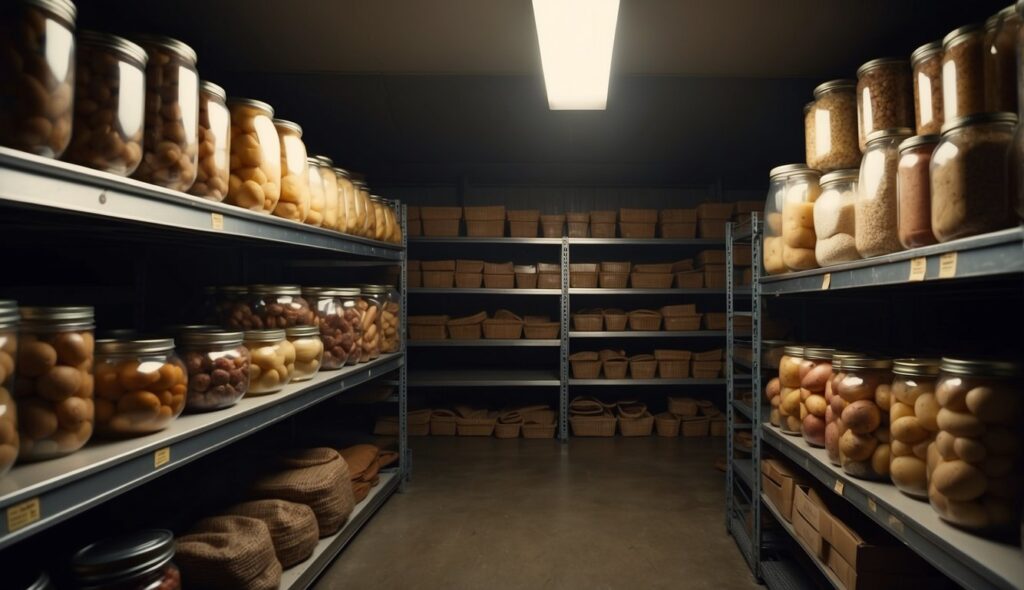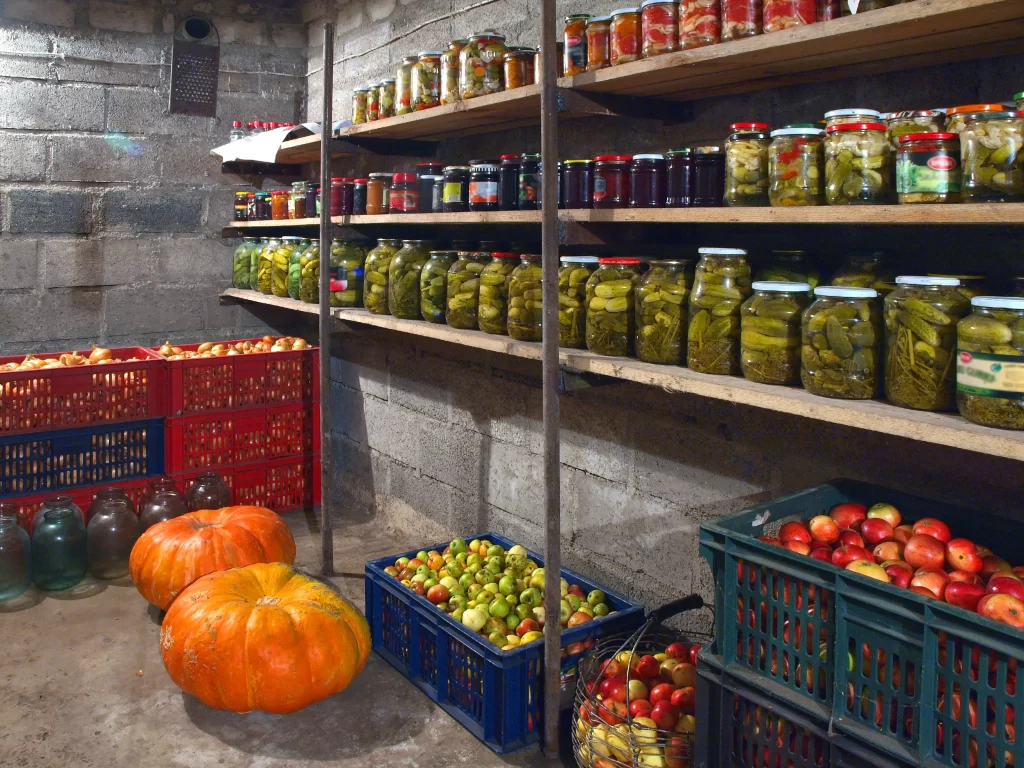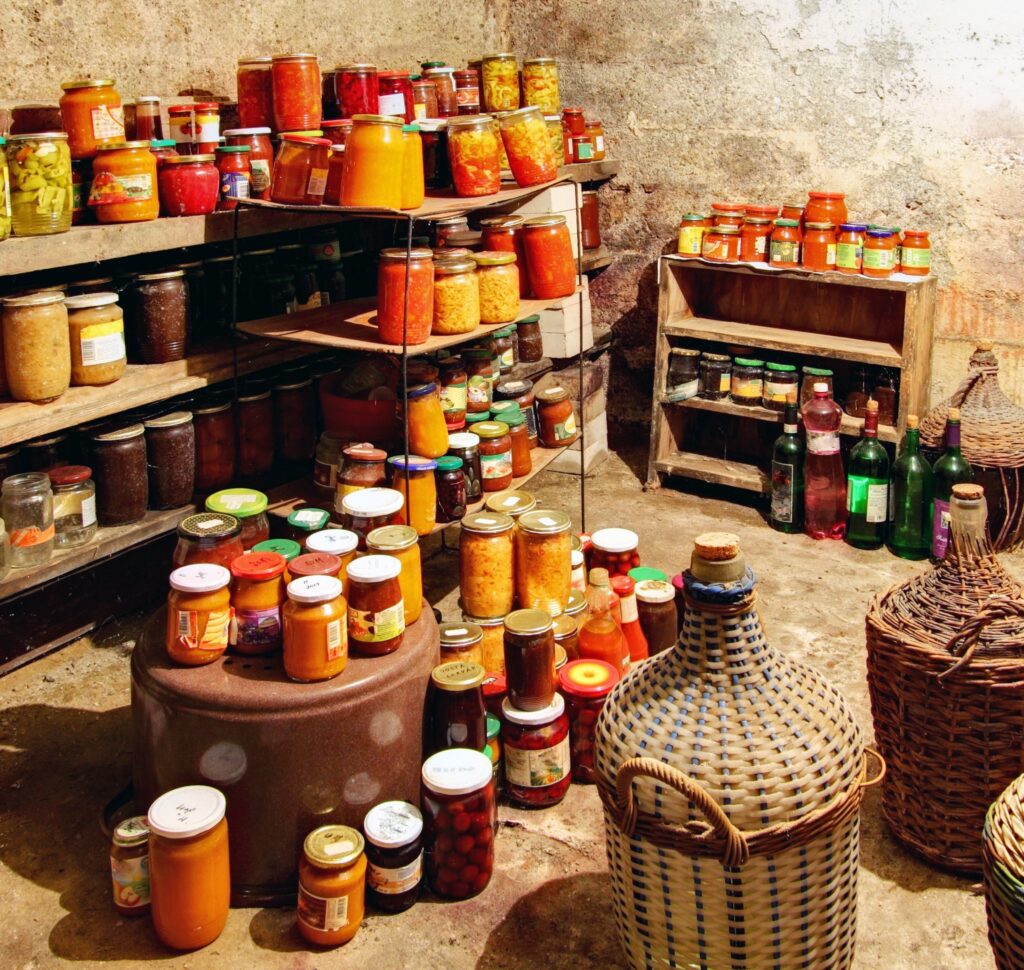As we look to traditions of the past for sustainable living practices, the relevance of the root cellar resurfaces. These underground food storage systems offer a natural and cost-effective solution for preserving a variety of food items.
Root cellars utilize the earth’s stable temperatures and natural humidity to keep produce fresh. As we navigate the intricacies of modern root cellars, we emphasize that careful planning and execution can lead to substantial benefits without incurring excessive costs.
Our exploration will take us through the fundamental aspects of food storage as well as the different designs of contemporary root cellars. We will discuss the most suitable foods for root cellar storage, organization techniques for optimal space utilization, and how to safeguard your stores from common threats. Emphasizing the importance of concealment and maintenance, we offer guidance to ensure the longevity and efficiency of your root cellar, contributing to sustainable living and food security.

The Value of a Root Cellar in Modern Times
Advantages of a Root Cellar for Long-Term Storage
Accessible Freshness Year-Round: Root cellars allow us to keep perishables like grains, nuts, and root vegetables fresh for extended periods. This age-old method provides an alternative to immediate consumption, enabling us to save our surplus produce.
Reducing Dependency on Electricity: Unlike modern refrigerators, root cellars do not rely on electricity. They harness the natural insulation of the earth, maintaining a consistent temperature range and high humidity level, ensuring optimal conditions for food preservation.
Aiding Farmers and Gardeners
Buffer Against Uncertainty: In uncertain times caused by natural disasters or economic challenges, a root cellar can be vital in safeguarding our food supply. When conventional systems fail, a well-stocked cellar can be critical for survival.
Support for Off-Grid Living: For those of us embracing an off-grid lifestyle, root cellars are indispensable. They represent a self-sufficient approach to food preservation, allowing us to be more resilient and less reliant on modern power grids.
Strategic Planning for Root Cellar Construction
Attention to Detail: Building a cellar is not to be rushed. Careful planning is essential to avoid mistakes that could endanger our food storage efforts. It requires time and consideration to create an efficient and reliable storage space.
Bullet Points on Why Root Cellars Matter:
- Resilience Improvement: In the face of disruptions, having a backup system for food preservation is not just practical – it’s potentially life-saving.
- Enhanced Food Security: A cellar bolsters our food security, particularly when other methods are not available or reliable.
- Sustainable Practice: By using natural earth temperatures, cellars align with sustainable practices and reduce our carbon footprint.
- Investment for Preparedness: Incorporating a cellar into our homestead is an investment in our preparedness for any situation.
By understanding the importance of root cellars, we recognize not only their historical significance but also their modern-day relevance. As part of a comprehensive approach to self-reliance, they remain an invaluable asset to our food preservation toolkit.

How Underground Food Storage Works
Utilizing the constant temperatures of the earth, we create a storage environment that is naturally cooler during summer and warmer during winter. This thermal stability is key to preserving perishable goods longer than they would last on a counter or in a pantry.
Here’s why underground storage excels:
- Stable Temperatures: Just 10 feet below the ground’s surface, the soil maintains temperatures between 50-60 degrees Fahrenheit.
- No Electricity Needed: This method stores food effectively without the use of electricity or modern refrigeration methods.
- Natural Insulation: Earth acts as an insulator. Layers of soil provide a buffer against extreme weather, maintaining a stable, cool environment that helps prevent spoilage.
To create an efficient underground storage space, we follow specific guidelines:
- Location: We make sure to build below the frost line to ensure consistent temperatures and prevent freezing.
- Insulation: The use of insulating materials like straw, wood, or hay helps to maintain the desired temperature and humidity levels.
- Materials: We choose materials like concrete, stone, or cinder block for their thermal properties and durability.
- Ventilation: Proper airflow is critical to manage humidity levels and to keep the air cool and fresh.
- Moisture Control: Drainage systems are crucial. We use gravel or sand to facilitate water movement away from our storage area.
By paying attention to these factors, we can preserve our food in a cool, dark, and humid environment that simulates the conditions of a modern refrigerator while being eco-friendly and sustainable. Our approach ensures that your roots and other perishable goods stay fresher for an extended period, leveraging what nature already provides.
Two Common Home-Built Root Cellar Storage Methods
The Compact Subterranean Container
We recognize that sometimes simplicity and cost-effectiveness are key. For those with limited resources or needing a quick solution, utilizing a compact underground space is ideal. By submerging sturdy containers such as metal trash bins or heavy-duty plastic drums, we can maintain a consistent temperature typically between 50-55 degrees Fahrenheit, depending on the regional climate.
- Ensure containers are resilient and not prone to water damage.
- Avoid materials like wood or cardboard due to their susceptibility to degradation.
This method harks back to traditional techniques of preserving food in the earth, offering a modern twist with improved materials. However, in colder regions, be wary that these containers can be challenging to access once the ground freezes, and sealed jars within may be at risk of bursting.
| Advantages | Considerations |
| + Affordable | – Limited space |
| + Maintains consistent temperatures | – Difficult access in freezing climates |
| + Simple to implement | – Regular digging to check on supplies |
As needs grow, so might the desire for a more sizable and accessible space you can walk into.
The Residential Garden Root Cellar
Moving beyond the simplicity of buried containers, constructing a walk-in root cellar in your backyard signifies a commitment to a robust, long-term storage solution. Though demanding more in terms of time and financial investment, such a cellar can accommodate a considerable stockpile of provisions.
A few salient points for those considering this option:
- A proper structure for this cellar allows for substantial stocking of supplies.
- A larger cellar is an asset in scenarios requiring long-term food preservation.
By investing in this type of project, we create a dedicated space that not only serves its purpose in everyday life but stands as a bastion of food security in the face of larger-scale disruptions. With careful planning and execution, a properly constructed root cellar is an immensely valuable resource for any household.
| Advantages | Considerations |
| + Sizable storage capacity | – Higher initial cost and labor |
| + Long-term food preservation | – Requires planning and construction skill |
| + Accessible |
In adopting either of these root cellar models, we appropriate ancient wisdom to our modern needs, enabling us to maintain a sustainable and secure food supply.

Crafting a Root Cellar – Step-by-Step Guide
Financial Planning
Before diving into construction, it’s crucial to evaluate your finances. Depending on available resources, aspirations for an elaborate setup may be tempered by budget constraints. While top-grade materials and a spacious design are ideal, economical alternatives can also provide a robust solution. It’s about balancing your desire for quality with the financial investments you’re prepared to make.
Excavating the Site
To start off our subterranean journey, we’ll carve out a space in the earth. The depth of our cellar should cater not only to concealment but also to achieving cooler storage temperatures. Whether beneath the house or out in an isolated spot, using excavation machinery can save time and labor, if the budget allows.
Establishing the Base
If finances permit, pouring a concrete base is our gold standard. However, we can use flat stones or wooden planks to create a pest-resistant and level foundation. The end goal is a solid flooring that facilitates easy organization of storage shelves.
Constructing the Walls
Brick or cinder block walls are preferable, but in their absence, we’ll resourcefully utilize nearby materials. Stone walls secured with natural binders such as clay will serve well. Embedding a moisture barrier between the earthen walls and interior keeps our storage dry and cool.
Implementing Airflow Solutions
Ventilation is non-negotiable for a root cellar. To manage airflow and deter ethylene gas accumulation, we integrate a vertical PVC pipe extending beyond the rooftop, complemented by another near the ground for fresh air intake.
Roofing the Retreat
Ideally, a concrete slab would secure our cellar, but an accessible alternative might involve treated 2x4s covered with the soil excavated earlier. Opting for materials that endure environmental wear is recommended, even at a higher upfront cost.
Fortifying the Enclosure
All gaps, especially around doors and the ceiling, demand sealing to block entry to pests that threaten our stored goods.
Securing the Entrance
A root cellar isn’t complete without a sturdy door equipped with a reliable lock, safeguarding our provisions. A robust locking mechanism ensures the fruits of our labor remain secure and undisturbed.
Our collective effort and adherence to these steps underpin the successful establishment of an efficient root cellar. With these guidelines, we’re well on our way to constructing a dependable storage space tailored to our needs.

Ideal Items for Cellar Storage
Essentials for Long-Term Storage
Stocking up on durable goods is wise for emergency preparedness. Learning to prepare foods like pemmican provides lasting protein, while hardtack serves as a dependable source of carbohydrates. The key is to keep a healthy stock of items that have a long shelf life, ensuring readiness for any situation.
Incorporating Fresh Produce
To make the most of our cellar, we include fresh fruits and vegetables. These require regular maintenance to ensure they remain edible until the next harvest. Storing fresh foods necessitates management of the temperature and humidity levels due to the natural by-products they emit, such as ethylene gas, which can accelerate spoilage.
Balancing Survival Provisions and Garden Yields
Self-sufficiency often means storing both long-term survival food kits and seasonally harvested garden produce. The challenge lies in managing the differing humidity needs—dry conditions for freeze-dried items and moist environments for fresh produce. High humidity levels, up to 90%, help prevent fresh garden yields from drying out, preserving their nutrition through the winter.
Storing Freeze-Dried Foods Elsewhere
Freeze-dried food, an investment in our emergency supplies, is best stored apart from our cellar to maintain its quality. Instead, it’s advisable to reserve the cellar for the annual harvest and manage the humidity appropriately, finding an alternative place for our freeze-dried goods, such as in a cool, dry basement.
Designing Divided Storage Zones
We can optimize our cellar by creating distinct zones—one for high-humidity items and another for those requiring drier conditions. This design choice allows for a single storage area accommodating both needs, although it complicates construction and organization.
Utilizing Protective Packaging
For the best protection of our survival food, sealing them in Mylar bags with desiccants and then placing these bags in airtight containers can be optimal. This method protects against the high humidity environment of the cellar interfering with long-term food supplies.
Regulating Cellar Humidity
Achieving the right humidity in our cellar is crucial. Root vegetables and leafy greens thrive in high humidity, close to that in a fridge’s produce drawer. Yet, we can’t alter the natural underground soil temperature, so we focus on managing humidity through proper ventilation and added moisture when necessary. Ventilation is essential for preventing the build-up of ethylene gas, which hastens the spoiling process.
To moderate humidity, we can set up a floor with gravel to add moisture easily or cover produce with damp burlap to gradually release moisture. Employing a hygrometer will help us monitor conditions to prevent excess humidity, which encourages decay. Our ventilation system may include two PVC pipes: one near the floor for fresh air intake and another at the top for exhaust, naturally maintaining airflow without the use of electricity.

Streamlining Root Cellar Arrangement
Effective Rack Solutions
By integrating shelving units, we fully utilize the vertical dimension of our storage area. These racks can be easily sourced through ready-to-assemble kits or by purchasing materials for custom setups. When we choose to craft our own, it grants us the ability to tailor dimensions to our unique space requirements, ensuring an impeccable fit and optimized storage capacity.
- Purchase pre-made shelving units for convenience
- Construct custom shelves for a personalized fit
- Maximize vertical storage space for improved organization
Transparent Container Organization
After shelving, further order can be achieved through the use of transparent containers. These bins facilitate quick identification of contents, saving time and maintaining organization. We steer clear of paper-based materials like cardboard due to their susceptibility to moisture damage. An important reminder for us is to avoid sealing containers storing fresh produce. This prevents ethylene gas build-up, which could spoil the food.
- Employ clear plastic bins for visibility and easy access
- Avoid using cardboard to prevent damage from humidity
- Keep fresh produce in unsealed containers to allow ethylene gas to escape
Threats to your Root Cellar
In our quest to safeguard our underground food reserves, we must be vigilant against a quintet of formidable adversaries:
- Bacteria: These microscopic invaders can wreak havoc on food integrity. You must store comestibles in pristine containers and promptly get rid of any items showing signs of spoiling.
- Mold and Fungi: The appearance of unwelcome mold or fungi on or near your stored produce is a sign of that the environment is ripe for decay. Monitoring is essential to spot these issues early.
- Insects: An infestation can swiftly overrun a cellar, making it essential to employ deterrent and eradication strategies to maintain a pest-free zone.
- Rodents and Other Vermin: These opportunistic scavengers are drawn to unprotected foods. Utilizing sealed, robust storage solutions and traps can help prevent their unwanted presence.
- Unauthorized Access by Individuals: Secrecy in the location of our food supply is critical to deter pilfering by others seeking to raid our stockpile. Camouflage techniques may be required.
To maintain a front against these threats, we must also focus on several key environmental controls within the cellar:
- Ventilation: Proper airflow is vital to disperse ethylene gas, which accelerates ripening and spoilage.
- Light Control: A dark environment minimizes the risk of premature ripening.
- Temperature and Humidity Management: Striking a balance with a consistent temperature and ideal humidity levels is crucial. You can use tools like thermometers and hygrometers to assist in sustaining suitable conditions. In case of overly dry air, a humidifier can introduce necessary moisture, while insulation ensures a steady climate against external temperature shifts.
How to Keep Your Root Cellar Hidden
To ensure the concealment of our root cellar, it’s crucial to merge it seamlessly with its surroundings. As we commit to building our subterranean food storage, let’s talk about effective camouflaging tactics.
First, when using smaller containers like a garbage can or heavy-duty plastic, we can easily disguise them with a layer of natural materials. Covering with soil, interspersing foliage, and scattering neighborhood-compatible debris such as twigs or pine cones can adequately conceal the presence of our DIY root cellar.
For larger structures requiring a more elaborate approach, we integrate native plantings into our design. Trees and shrubs indigenous to the region create a natural screen, effectively masking our food haven. We dedicate care to bury the foundation beneath the frost line, strategically selecting a location that’s inconspicuous while considering the water table level, to prevent flooding.
Aiding in its disguise, we meticulously plan the access points—doors camouflaged within the landscape or beneath outbuildings. This careful planning extends to the inclusion of essential features such as a foundation sturdy against storms, effective drainage to manage excess water, and a ventilation system crucial for temperature and humidity control.
Maintaining Your Cellar Food Supply
To keep our root cellar’s food supply in prime condition, we attend to several crucial tasks regularly. Vigilantly monitor the expiration dates on preserved goods and rotate stock to ensure freshness. A well-maintained tracking system, ideally a spreadsheet with clear labeling of contents and their shelf life, assists in managing our stock effectively.
Key practices for root cellar upkeep:
- Inspect Seals: Regularly examine the doors and walls for any signs of wear or damage to maintain a stable environment within the cellar.
- Climate Control: Keep a close watch on the temperature and humidity levels to protect the freshness of fruits and vegetables such as apples, carrots, and potatoes.
- Restocking: Promptly replenish consumed or discarded items, maintaining an inventory of homegrown produce and canned goods.
- Lock Maintenance: Ensure locks are free from rust to prevent any security issues.
Final Thoughts
Through centuries, we have utilized subterranean storage to stave off hunger. This enduring practice not only offers a steadfast option during tumult but serves our daily sustenance needs. Here are key points to remember:
- Preservation: Underground storage remains a robust method for preserving food.
- Off-Grid Advantages: Perfect for those living off-grid, promoting self-reliance.
- Maintenance Ease: Requires minimal upkeep once established.
- Commissioning Benefits: Building a cache has immediate and long-lasting benefits.
- Reducing Food Waste: Helps in keeping grocery-bought produce fresh for longer.


